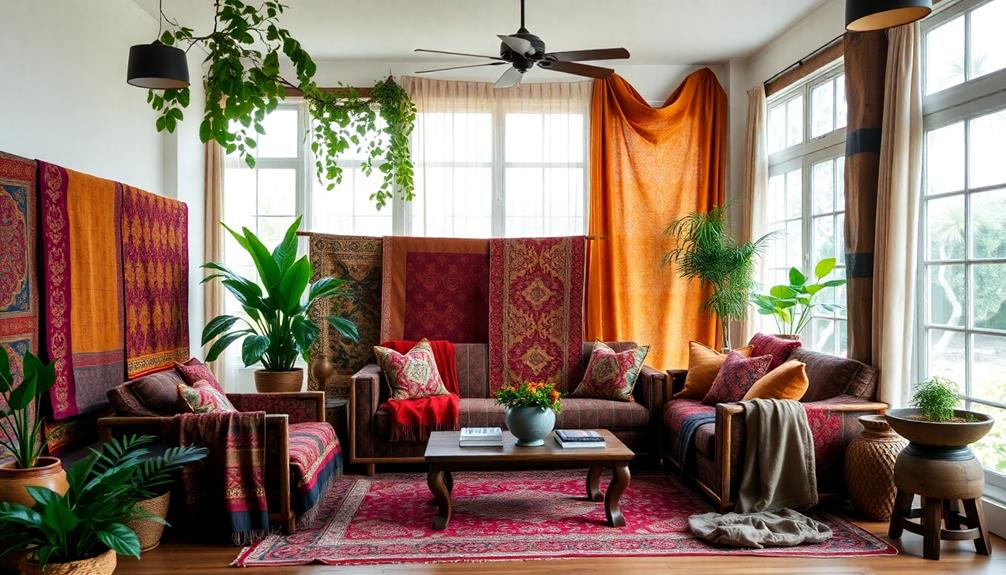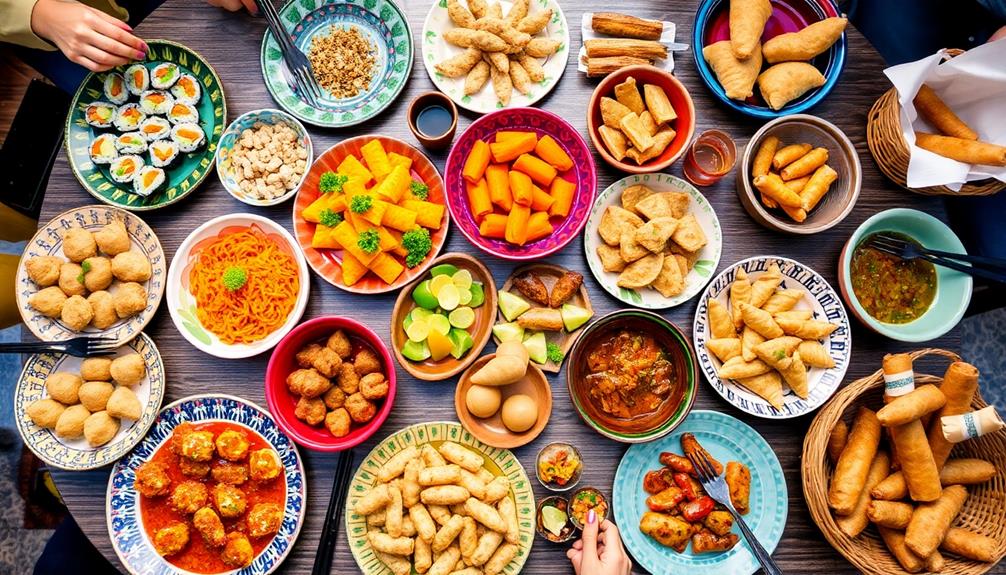Indonesian textiles add a splash of color and culture to your home, offering timeless elegance through vibrant patterns and ancient techniques. From the intricate wax-resist designs of Batik to the luxurious gold-threaded Songket, each textile tells a story and reflects local heritage. You can easily incorporate these beautiful pieces into your decor, whether it's with decorative pillows, wall art, or table runners. Plus, with a focus on sustainable practices and fair trade, you'll feel good about your choices. Explore how to blend these exquisite textiles into your space for a unique touch that speaks to your style.
Key Takeaways
- Indonesian textiles, including Batik, Ikat, and Songket, showcase vibrant colors and intricate designs that enhance home decor with cultural significance.
- Traditional weaving techniques and natural dyes highlight the artistry and sustainability of Indonesian textiles, promoting eco-friendly practices in production.
- Batik can be used for wall art and table linens, while Ikat works well for cushions and curtains, integrating seamlessly into various decor styles.
- Songket fabrics add luxury and texture, making them ideal for throw blankets and rugs in elegant home settings.
- Incorporating ceremonial textiles as table runners and decorative accents can elevate your home's aesthetic, reflecting rich cultural heritage.
Overview of Indonesian Textiles

Indonesian textiles are a vibrant tapestry of cultural heritage, showcasing unique techniques like Batik, Ikat, and Songket. Each of these methods reflects not only artistic skill but also the diverse patterns and textures that emerge from Indonesia's rich geography.
When you investigate Batik, you'll notice its intricate wax-resist dyeing process, resulting in stunning visual designs that tell stories of the land and its people. The craftsmanship involved in creating these textiles is akin to that found in Indonesian decor masks, where traditional techniques and cultural narratives come together.
Ikat, on the other hand, employs a fascinating tie-dye technique that creates blurred patterns before the fabric is woven, adding a distinct charm.
Songket stands out with its luxurious patterns made from gold and silver threads, often reserved for ceremonial garments and special occasions, elevating the textile to a work of art. The use of natural materials in traditional weaving practices is essential, as artisans rely on local plants for dyes, preserving techniques passed down through generations.
As you explore the world of Indonesian textiles, you'll appreciate how each region, from Sumatra to Borneo to Sulawesi, offers unique craftsmanship that reflects local customs and histories, making every piece a treasure in its own right.
Cultural Significance of Textiles
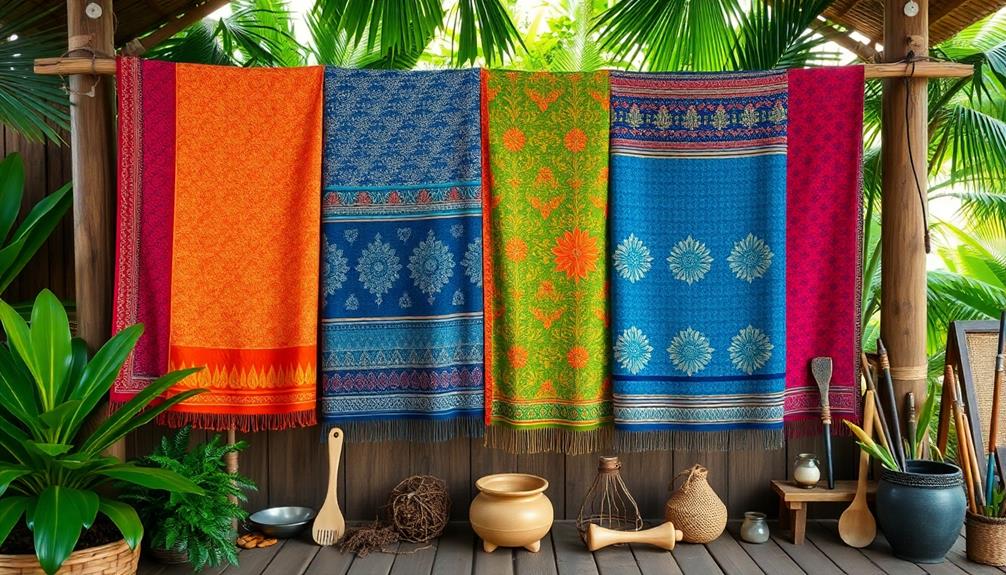
Textiles hold a profound cultural significance in Indonesia, embodying the rich tapestry of local customs and historical narratives. Each piece tells a story, reflecting the artistry and dedication of artisans who preserve these traditions.
By incorporating Indonesian textiles into your home decor, you not only enhance aesthetics but also celebrate a vibrant culture. Additionally, the use of vibrant artistry in Indonesian decor masks can complement the textiles, creating a harmonious blend of cultural elements in your space traditional artistry in masks.
Consider the following elements that showcase their importance:
- Vivid Patterns: Each intricate design symbolizes local customs and social status.
- Cultural Events: Specific textiles are reserved for traditional ceremonies, emphasizing their role in rituals.
- Regional Diversity: From Batik to Ikat, each type reflects unique artistry from different islands.
- Historical Influence: Textiles carry stories of trade routes and intercultural exchanges, making them living narratives of history.
Types of Traditional Textiles
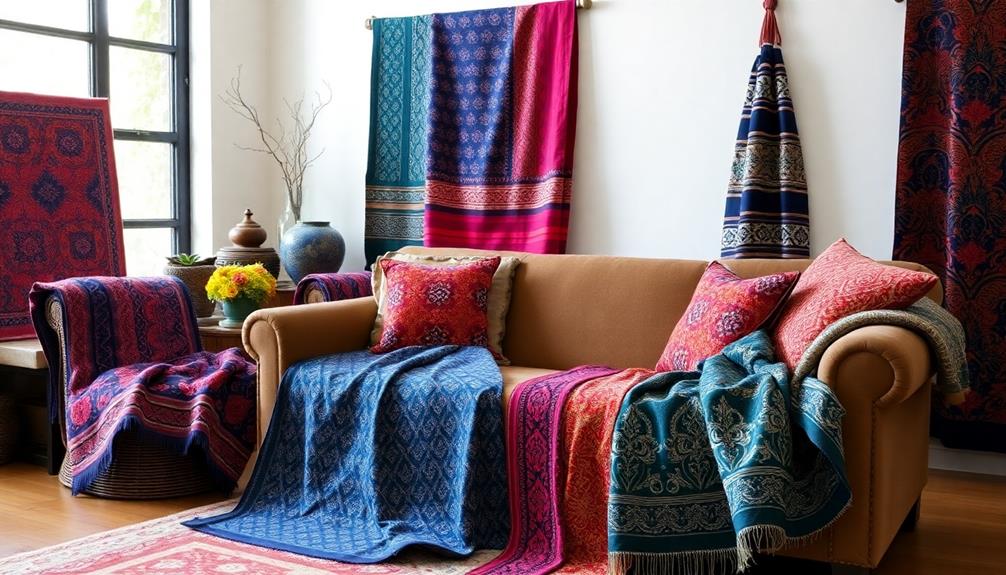
When you explore Indonesian textiles, you can't miss the stunning diversity that includes Batik, Ikat, and Songket.
Each type showcases unique techniques and cultural significance, from the intricate wax-resist patterns of Batik to the luxurious threads woven into Songket.
Indonesian decorative pillows often feature these textiles, enhancing living spaces with their vibrant colors and intricate patterns.
Let's take a closer look at these traditional masterpieces that reflect Indonesia's rich heritage.
Batik: Wax-Resist Masterpieces
Batik, a stunning example of Indonesia's rich cultural heritage, captivates with its intricate wax-resist dyeing technique that creates breathtaking patterns on fabric. This art form, with roots dating back over a thousand years, showcases the craftsmanship of both Batik Tulis, hand-drawn with a canting tool, and Batik Cap, made with stamps for uniformity.
Each piece tells a story, often rich in symbolism, much like the importance of Indonesian decor masks that enhance aesthetic appeal and cultural appreciation.
When you incorporate batik fabric into your home, you're not just adding a textile; you're infusing your space with timeless elegance. Picture the vibrant hues and intricate designs that can transform your interiors:
- Deep indigos and golden yellows swirling together
- Delicate floral motifs representing nature's beauty
- Geometric patterns echoing cultural stories
- Rich reds symbolizing prosperity and joy
Whether draped as curtains, accent pillows, or even wall art, batik fabric enhances both traditional and contemporary styles.
Embrace this unique artistry and let each piece of batik weave a narrative into the fabric of your home, celebrating the beauty of Indonesian heritage while adding a touch of elegance to your decor.
Ikat: Tie-Dye Technique
Ikat is a fascinating traditional tie-dye technique that brings vibrant color and intricate patterns to life. This method involves binding and dyeing yarns before weaving, resulting in unique, blurred designs that add depth to the final ikat fabric. Originating as far back as the 10th century, ikat has evolved, particularly in Indonesia, showcasing bold colors and complex motifs crafted by skilled artisans.
The versatility of ikat makes it a wonderful choice for home decor, adding a touch of sophistication to items like curtains, cushions, and upholstery. Here's a quick overview of some ikat features:
| Feature | Description |
|---|---|
| Dyeing Technique | Yarn is dyed before weaving, creating intricate patterns. |
| Cultural Significance | Each design tells a story, reflecting regional characteristics. |
| Visual Appeal | Unique blurriness adds movement and depth to textiles. |
| Usage | Ideal for various decor styles, from traditional to contemporary. |
Embracing ikat in your home decor not only enhances aesthetics but also connects you to rich cultural traditions.
Songket: Luxurious Patterns
Discover the elegance of songket, a traditional Indonesian textile that captivates with its luxurious patterns woven from gold or silver threads. This exquisite fabric is more than just a textile; it's a symbol of wealth and status, often showcased during cultural ceremonies.
The intricate designs are created using a supplementary weft technique, showcasing vibrant, shimmering motifs that tell stories of rich history and artistry. Songket fabrics can also be integrated into event and party designs, enhancing the ambiance with their stunning visual appeal, particularly during weddings and festive celebrations, where Indonesian wedding decor ideas come to life.
When you think of songket, imagine:
- Golden threads glimmering under the light, creating a mesmerizing effect.
- Intricate floral and geometric patterns that reflect local cultural identities.
- Fabrics draped elegantly during weddings and ceremonial events, embodying tradition.
- Handcrafted creations by skilled artisans, preserving the essence of traditional art.
Regions like Sumatra and Bali are particularly famous for their songket textiles, each featuring unique patterns and colors. These fabrics are versatile, suitable for ceremonial clothing, home decor, and special occasions.
Skilled artisans dedicate years to mastering the complex weaving techniques, ensuring that this traditional art form thrives for future generations. Embrace the luxurious patterns of songket to enrich your home with timeless elegance.
Craftsmanship and Techniques
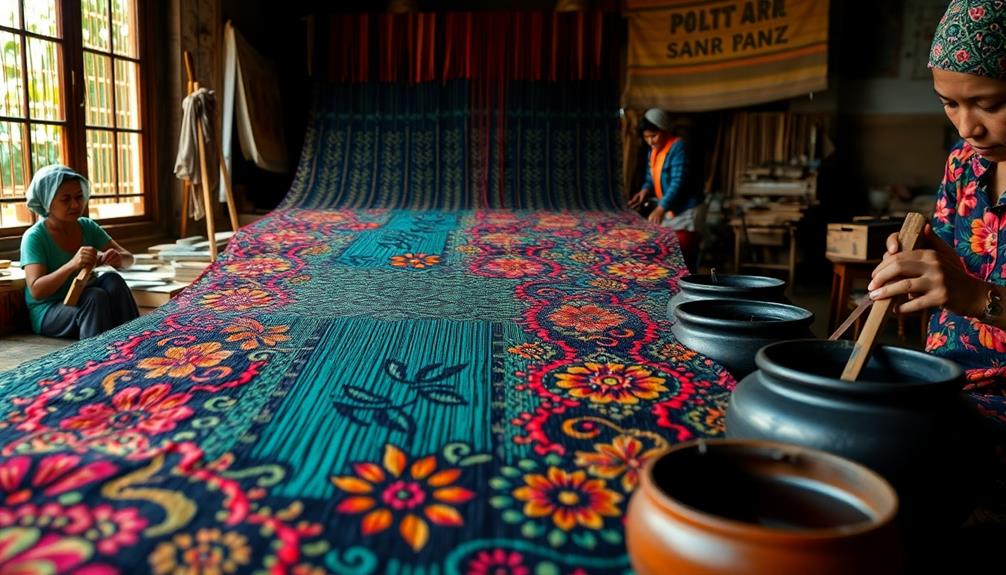
When you explore Indonesian textiles, you'll notice the exceptional weaving techniques that artisans use to create stunning patterns, often inspired by the intricate designs seen in traditional Indonesian style home decor.
These craftsmen rely on natural dyes sourced from local plants, reflecting both sustainability and cultural significance.
Understanding these traditions gives you a deeper appreciation for the artistry behind each textile piece.
Weaving Techniques Overview
In the rich tapestry of Indonesian textiles, traditional weaving techniques play a crucial role in showcasing the country's diverse cultural heritage. Each method brings a subtle touch of artistry and history, capturing the essence of the regions from which they originate.
Traditional Indonesian housing also reflects regional identity and craftsmanship, paralleling the intricate designs found in textiles. Here are some key weaving techniques you'll encounter:
- Batik: This ancient wax-resist dyeing method displays intricate designs that reflect social status and artistic expression.
- Ikat: Involves binding yarns before dyeing to create stunningly blurred patterns, adding depth and movement to the fabric.
- Songket: A luxurious brocade weaving technique, often embellished with gold or silver threads, evoking opulence and tradition.
- Tenun: Handwoven fabrics that exhibit regional motifs, showcasing the skills and creativity of the artisans.
These weaving techniques not only highlight the craftsmanship of Indonesian artisans but also emphasize the significance of preserving cultural heritage.
Natural Dye Sources
Natural dyes are a vibrant and essential part of Indonesian textiles, offering a spectrum of colors derived from local plants. You'll find indigo from the indigofera plant creating deep blues, while turmeric provides bright yellows.
Artisans skillfully extract pigments by boiling plant materials and immersing the yarns, showcasing their expertise in achieving rich, vivid colors. This craftsmanship reflects the cultural heritage embedded in Balinese design characteristics, as artisans incorporate traditional techniques into their work.
One traditional technique used is mordanting, where substances like alum fix the dye to the fabric. This process guarantees the colors remain long-lasting, even when exposed to washing and sunlight.
By employing these natural methods, artisans not only enhance the beauty of their textiles but also embrace an eco-friendly approach to craftsmanship, promoting sustainability in textile production.
Moreover, each color holds cultural significance, with specific hues symbolizing different meanings across various Indonesian communities. This connection between color and culture enriches the narrative behind each textile piece, making them more than just decorative items in your home.
Artisan Crafting Traditions
Artisan crafting traditions in Indonesia are a demonstration of the skill and dedication of master weavers who pour their heart into every textile.
These artisans employ techniques passed down through generations, creating textiles that aren't only stunning but rich in cultural significance. The intricate artistry is particularly evident in unique pieces like Batik, Ikat, and Songket, each representing different regions and their heritage.
Many of these textiles can be beautifully complemented by luxury tropical designs, enhancing the overall aesthetic of your living space.
Imagine the following as you explore these textiles:
- Vibrant colors from natural dyes sourced from local plants
- The Ikat technique, with its beautifully blurred designs
- Weaving methods that tell stories of community history
- The painstaking process that can take days to complete a single piece
Through the use of natural materials, each textile becomes a storytelling artifact, embodying local customs and traditions.
Whether you're drawn to the textural depth of Ikat or the symbolism in Batik, you'll appreciate the dedication and craftsmanship involved.
Incorporating Textiles in Home Decor
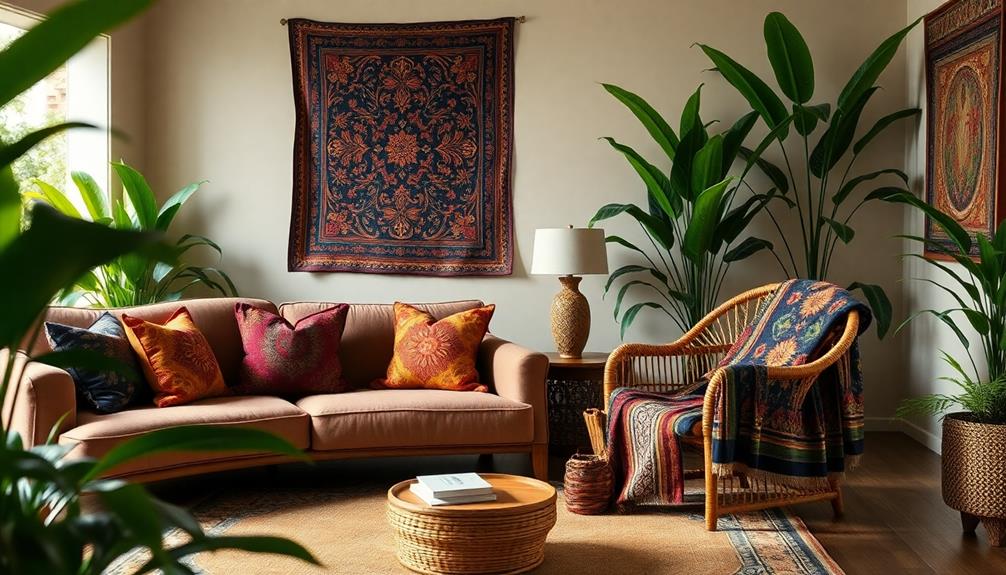
Incorporating Indonesian textiles like Batik, Ikat, and Songket into your home decor can instantly transform your space with vibrant colors and intricate patterns. These textiles not only enhance the aesthetic appeal but also create an inviting atmosphere filled with cultural richness and uniqueness.
You can easily use handwoven Ikat fabrics for soft furnishings like cushions and curtains. Their versatile designs blend seamlessly with various decor styles, from traditional to modern. Layering traditional textiles as wall hangings or table runners adds texture and interest while reflecting the artistry of Indonesian craftsmanship.
Here's a quick reference table for your textile decor ideas:
| Textile Type | Suggested Use |
|---|---|
| Batik | Wall art, table linens |
| Ikat | Cushions, curtains |
| Songket | Throw blankets, rugs |
| Ceremonial | Table runners, decor |
The natural dyes used in these textiles promote eco-friendliness, derived from local plants and sustainable practices. Plus, many textiles can be customized to fit your specific needs, ensuring they perfectly suit your home decor. Embrace the beauty of Indonesian textiles and elevate your living space today!
Ikat: History and Versatility
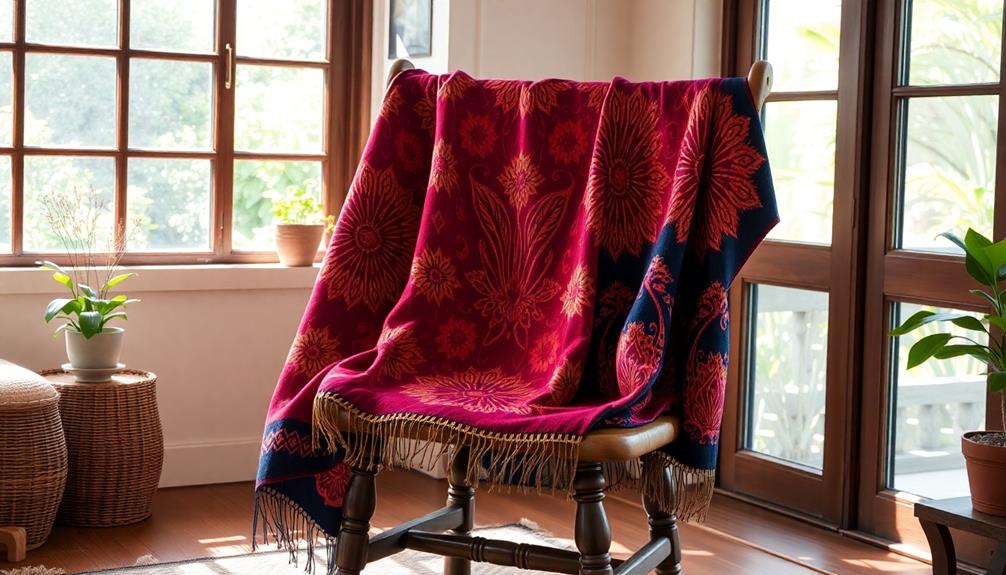
Although ikat textiles have roots that stretch back to the 10th century, their vibrant colors and intricate patterns continue to captivate modern audiences. This traditional Indonesian craft employs a resist-dyeing technique that creates unique blurriness in the designs, giving depth and character to each piece.
Skilled artisans use natural dyes from local plants, ensuring that every ikat textile embodies rich cultural heritage and artistry. Much like the principles found in tropical contemporary house design, ikat enhances the aesthetic appeal of living spaces by incorporating an artistic flair that complements the surrounding environment.
Ikat's versatility makes it a perfect choice for various home decor items, allowing you to blend traditional elegance with contemporary design.
Consider incorporating ikat into your space with:
- Bold curtains that frame your windows
- Plush cushions that add comfort to your seating area
- Striking table runners that elevate your dining experience
- Accent pieces that bring warmth to a room filled with wood and stone
With ikat, you can effortlessly create an inviting atmosphere that resonates with timeless elegance.
You'll find that these textiles not only enhance your decor but also tell a story, bridging the past and present in a beautifully woven tapestry of style. Embrace ikat and transform your home into a sanctuary of artistry.
Sustainable Practices in Textile Production
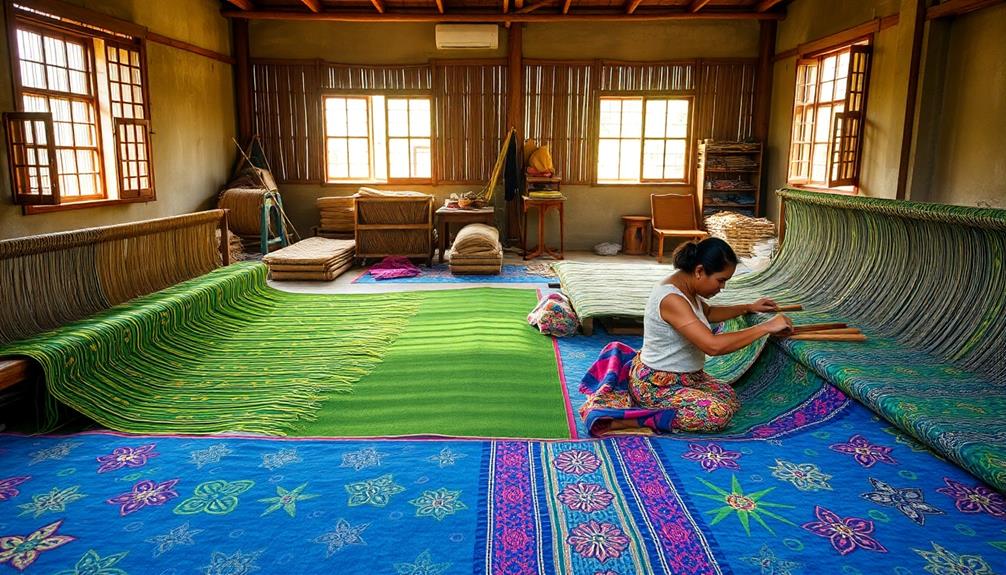
Indonesia's textile industry is increasingly embracing sustainable practices that reflect a deep respect for both the environment and cultural heritage. By using natural dyes derived from local plants, artisans markedly reduce the environmental impact compared to synthetic alternatives. This commitment to eco-friendliness contributes to a cleaner, greener future for the industry.
Traditional weaving techniques require minimal machinery and energy, preserving cultural heritage while supporting sustainable practices. You'll appreciate how artisans utilize locally sourced materials like organic cotton and bamboo, which not only support sustainable farming but also minimize carbon footprints associated with transportation.
Moreover, many textile producers adhere to fair trade principles, ensuring that artisans receive fair wages and work in safe conditions. This fosters community development and strengthens local economies.
The revival of ancient techniques, such as ikat and batik, highlights the importance of sustainability in preserving cultural identity and craftsmanship.
Accessorizing With Indonesian Fabrics
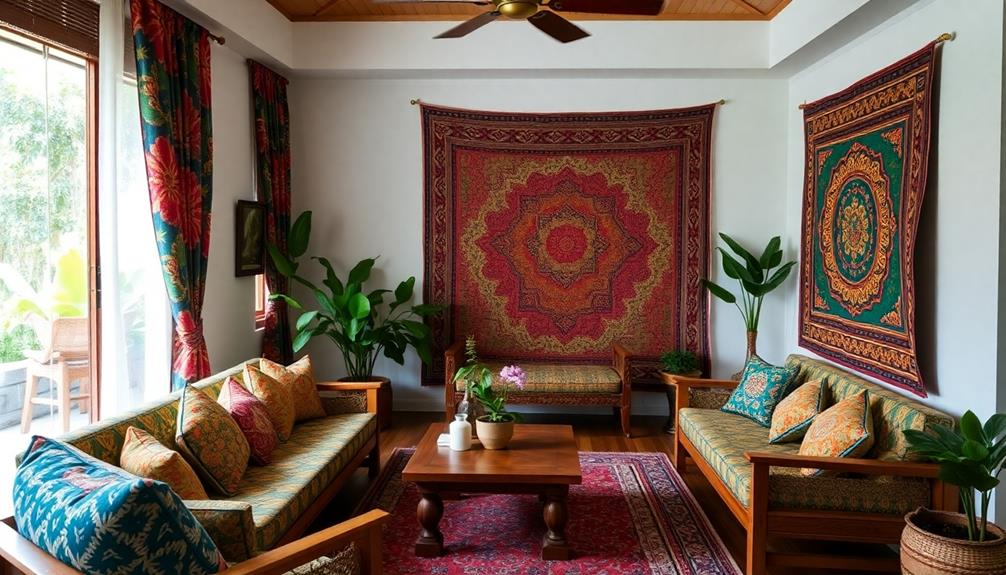
Accessorizing with Indonesian fabrics can transform any space into a vibrant showcase of culture and artistry. These textiles, like Ikat and Batik, boast rich colors and intricate patterns that elevate your home decor. By incorporating these stunning pieces, you'll create a beautiful color palette that reflects your unique style while also making bold statement pieces.
Consider adding Indonesian textiles through:
- Handcrafted decorative pillows that invite comfort and conversation
- Unique wall hangings telling stories of heritage and artistry
- Luxurious table runners that bring elegance to any dining experience
- Soft cushions and throws that add warmth and texture to your living space
The durability and comfort of high-quality Indonesian fabrics make them perfect for soft furnishings, allowing you to enjoy both beauty and functionality.
Plus, many suppliers offer tailored options to guarantee your accessories fit seamlessly into your interior design. By mixing traditional and contemporary designs, you can achieve a harmonious blend of cultural elegance and modern style, turning your home into a true reflection of artistry and personal flair.
Frequently Asked Questions
What Is the Indonesian Textile Technique?
Indonesian textile techniques include Batik's wax-resist dyeing, Ikat's pre-dyed yarns, and Songket's luxurious threads. Each method showcases unique patterns and cultural significance, reflecting the rich history and artistry of Indonesia's diverse regions.
What Are the Traditional Indonesian Textiles?
Indonesian textiles tantalize with traditional techniques like Batik, Ikat, Songket, and Tenun. Each fabric's fascinating flair reflects regional roots, vibrant colors, and meticulous craftsmanship, ensuring you appreciate the artistry woven into every piece you encounter.
What Are the Fabric and Fabric Design of Indonesia?
Indonesia's fabrics, like Batik, Ikat, Songket, and Tenun, showcase stunning designs and rich textures. You'll find intricate patterns, luxurious threads, and unique weaving techniques that reflect the region's vibrant culture and artistic heritage.
How Big Is the Textile Industry in Indonesia?
The textile industry in Indonesia's massive, contributing about $6 billion annually to the economy. With over 3,000 companies and 2.5 million workers, it plays a crucial role in employment and manufacturing growth.
Conclusion
As you weave Indonesian textiles into your home, think of each piece as a thread in the vibrant tapestry of life. These fabrics, rich with history and culture, invite you to dance with tradition while embracing modern elegance. Just like a river flowing through lush landscapes, let their colors and patterns guide your creativity, transforming your space into a sanctuary of warmth and beauty. Embrace the stories they tell, and watch your home come alive with timeless charm.
